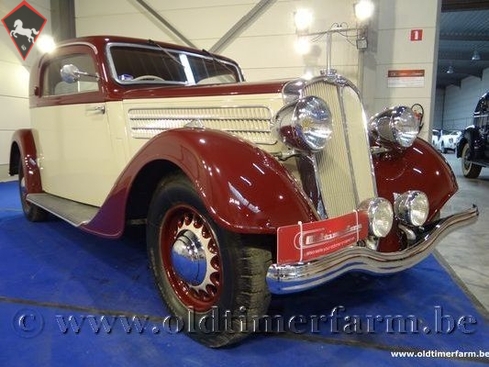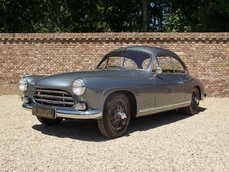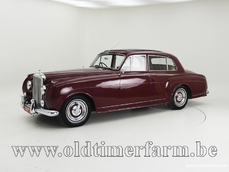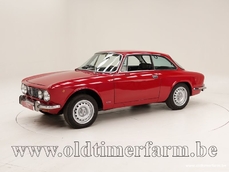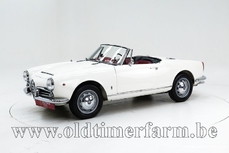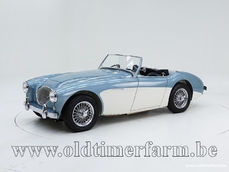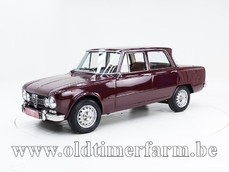Salmson S4 DA Coupé 10CV '37 1937
General description :
Lowered price from €35.000 -> €32.000
The Salmson S4 is a mid-size executive-level car introduced as the Salmson S4 C by Société des Moteurs Salmson in Autumn 1932.[1] It was the manufacturer's principal or sole model for the next twenty years. The car's 1465 cc 4-cylinder engine initially placed it in the 8CV car tax band which would have placed it alongside cars such as the Peugeot 301 and the Renault Monaquatre, but the Salmson's levels of technical sophistication and equipment, as well as its price, indicated that it was intended for a more aspirational clientele than these comparably sized cars. Within a few years the S4's 4-cylinder engine had in any event increased in size to a point where the car sat in the 10CV car tax band, which moved the S4 up half a class as well as providing customers with a more convincing level of performance. The engines grew and the range widened. A 2.3-litre variant, the Salmson S4 E joined the less powerful car (by now itself having evolved into the Salmson S4 DA) in October 1937. The war disrupted production, which probably stopped completely after a major bomb attack conducted by the British on 3 March 1942. Post war production resumed (or continued), albeit at feeble levels, of the 4-cylinder (10CV) Salmson S4-61 till April 1952, by which date production of the 13CV Salmson S4 E had already come to an end. In October 1936, with several thousand "Salmson S4 "s sold over the previous two years, the manufacturer used the Motor Show to launch a further upgrade.[2] The 4-cylinder engine retained its twin overhead camshafts, and the length of the piston stroke was unchanged, but a further increase in cylinder bore (diameter) provided for a further increase in capacity, now to 1731 cc.[2] The cylinder head now featured hemispherical piston heads and centrally positioned spark plugs, which gave the engine a level of responsiveness not normally associated with a 10CV engine.[2] The car shared its place in the 10CV tax band with the recently introduced Peugeot 302.[2] Where comparably bodied versions existed, however, the Salmson S4 DA was nevertheless priced approximately 50% higher than the Peugeot 302: there was evidently no need for Salmson to compete on price with the volume automakers. By now the S4 had acquired independent front suspension, using a transverse leaf spring. The back wheels were, as before, attached to a rigid axle suspended with longitudinal leaf springs. At the 30th Paris Motor show in October 1936 the car was offered in bare chassis form at 24,000 francs. A four seater 2-door "coupė" bodied car was priced at 31,500 francs while the sedan/saloon bodied car – now described not as a "berline" but with the more traditional term "conduite intėrieur" came in at 32,800 francs. As before, the saloon/sedan bodied car had a sedate old fashioned appearance that offered no hint of the modern technology underneath. The "roadster" was priced at 35,500 francs and the four seater cabriolet at 35,900 francs. In every case, the price included a four-speed manual transmission (brought in from Delahaye), but for an extra 1,500 francs customers could specify a "Cotal Preselector transmission".In the immediate aftermath of the economic depression that hat hit western economies in the aftermath of the 1929 Wall Street Crash, price inflation had gone into reverse and the domestic purchasing power of the French currency had begun to increase. The mid 1930s saw renewed economic paralysis in France, however, and during the second half of the decade price inflation returned with a vengeance. The Salmson S4-DA which the manufacturer had adverstized in bare chassis form for 24,000 francs in October 1936 was priced, in January 1938, at 31,200 francs: there were equivalent price increases for cars with bodies fitted. This inline engine configuration is the most common in cars with a displacement up to 2.4 L. The usual "practical" limit of the displacement of inline-four engines in a car is around 2.7 L.[citation needed] However, Porsche used a 3.0 L four in its 944 S2 and 968 sports cars, the International Harvester Scout was available with a 3.2 L inline four from 1965 until 1980 and Rolls-Royce produced several inline-four engines of 2,838 cc with basic cylinder dimensions of 3.5 in (89 mm) diameter and 4.5 in (110 mm) stroke (Rolls-Royce B40). Early vehicles also tended to have engines with larger displacements to develop horsepower and torque. The Model A Ford was built with a 3.3 L inline-four engine. Displacement can also be very small, as found in kei cars sold in Japan, such as the Subaru EN series; engines that started out at 550 cc and are currently at 660 cc, with variable valve timing, DOHC and superchargers resulting in engines that often claim the legal maximum of 64 PS (47 kW; 63 bhp). Specifications Weight: kg (lb): 1150 (2538) Mechanics. Displacement: inline 4 1731 cc (106 cid), front-mounted Valve gear: 8 Fuel system: 1 carburettor Gearbox: 4-speed manual Driven wheels: rear-wheel drive Maximum power: 51 hp at 3800 rpm Maximum speed: 120 km/h (75 mph)
http://www.oldtimerfarm.be/en/collection-cars-for-sale/3020/salmson-s4-da-coupe-10cv-37.php
1937 Salmson S4 DA Coupé 10CV '37 is listed sold on ClassicDigest in Aalter by Oldtimerfarm Dealer for €32000.
Car Facts
Car type : Car Make : Salmson Model : S4 Model Version : DA Coupé 10CV '37 Engine size : 0.0 Model Year : 1937 Sub type : Coupé Location : Aalter
Sold
Seller Information
Sold
People who viewed this Salmson S4 also viewed similar Salmson listed at ClassicDigest
Other cars listed for sale by this dealer
About Salmson
Salmson was a French engineering company known for producing automobiles, airplane engines, and pumps. The company, founded by Émile Salmson in 1890, initially focused on manufacturing steam-powered machinery and later shifted its attention to producing combustion engines.In the automotive realm, Salmson gained prominence primarily in the 1920s and 1930s for its production of high-quality, reliable, and technologically advanced cars. They were recognized for their innovative designs and engineering prowess. Salmson cars were renowned for their performance in motorsports, particularly in endurance racing events like the 24 Hours of Le Mans.
One of Salmson's notable achievements was the production of the Salmson 2A2 aircraft during World War I, which became one of the most successful French fighter planes of the era. The experience gained in producing aviation engines contributed to the development of their high-performance automotive engines.
However, despite their success and reputation for engineering excellence, Salmson faced financial difficulties, especially during economic downturns and the aftermath of World War II. The company eventually ceased its automobile production in the late 1950s.
Today, vintage Salmson cars are sought after by collectors and automotive enthusiasts due to their historical significance, engineering innovation, and unique design features.
